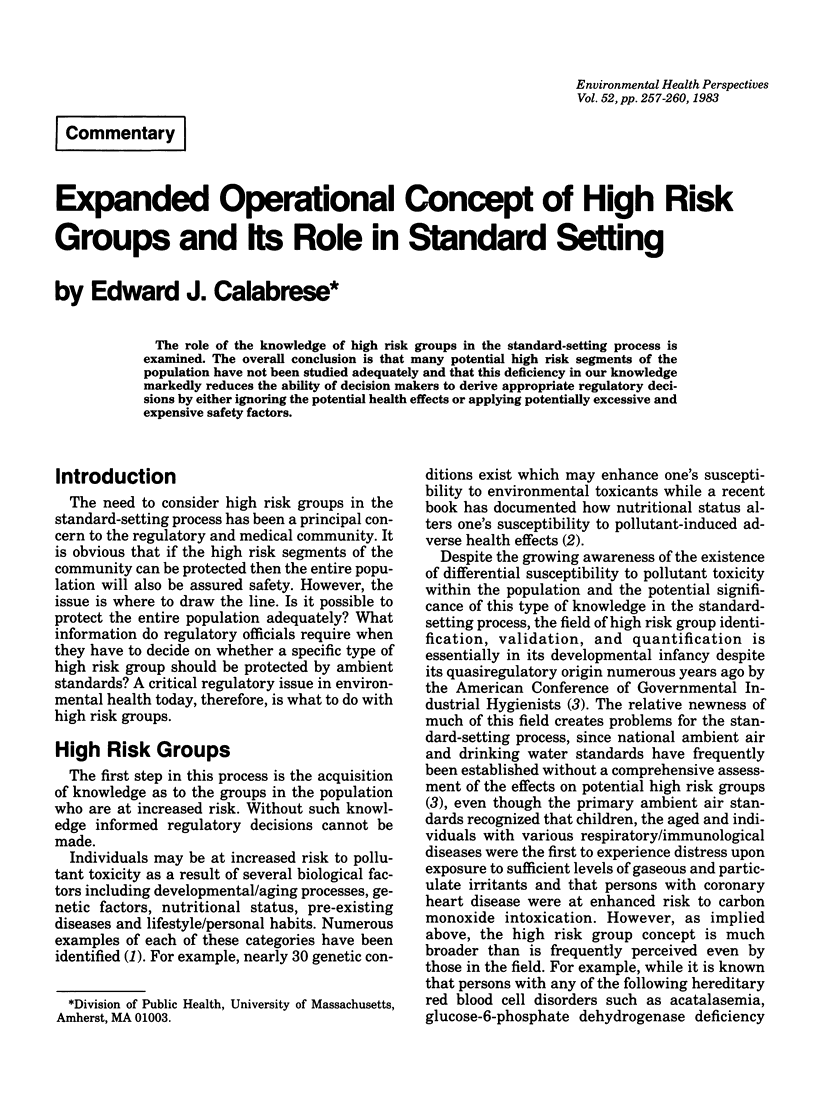Abstract
The role of the knowledge of high risk groups in the standard-setting process is examined. The overall conclusion is that many potential high risk segments of the population have not been studied adequately and that this deficiency in our knowledge markedly reduces the ability of decision makers to derive appropriate regulatory decisions by either ignoring the potential health effects or applying potentially excessive and expensive safety factors.
Full text
PDF



Selected References
These references are in PubMed. This may not be the complete list of references from this article.
- Agar N. S., Gruca M., Harley J. D. studies on glucose-6-phosphate dehydrogenase, glutathione reductase and regeneration of reduced glutathione in the red blood cells of various mammalian species. Aust J Exp Biol Med Sci. 1974 Aug;52(4):607–614. doi: 10.1038/icb.1974.59. [DOI] [PubMed] [Google Scholar]
- Amma E. L., Sproul G. D., Wong S., Huisman T. H. Mechanism of sickling in deer erythrocytes. Ann N Y Acad Sci. 1974 Nov 29;241(0):605–613. doi: 10.1111/j.1749-6632.1974.tb21917.x. [DOI] [PubMed] [Google Scholar]
- Bannerman R. M., Edwards J. A., Kreimer-Birnbaum M. Investigation of potential animal models of thalassemia. Ann N Y Acad Sci. 1974;232(0):306–322. doi: 10.1111/j.1749-6632.1974.tb20595.x. [DOI] [PubMed] [Google Scholar]
- Castro O., Orlin J., Rosen M. W., Finch S. C. Survival of human sickle-cell erythrocytes in heterologous species: response to variations in oxygen tension. Proc Natl Acad Sci U S A. 1973 Aug;70(8):2356–2359. doi: 10.1073/pnas.70.8.2356. [DOI] [PMC free article] [PubMed] [Google Scholar]
- Evans E. T. Sickling phenomenon in sheep. Nature. 1968 Jan 6;217(5123):74–75. doi: 10.1038/217074a0. [DOI] [PubMed] [Google Scholar]
- Feinstein R. N., Braun J. T., Howard J. B. Nature of the heterozygote blood catalase in a hypocatalasemic mouse mutant. Biochem Genet. 1968 Jan;1(3):277–285. doi: 10.1007/BF00485182. [DOI] [PubMed] [Google Scholar]
- Maral J., Puget K., Michelson A. M. Comparative study of superoxide dismutase, catalase and glutathione peroxidase levels in erythrocytes of different animals. Biochem Biophys Res Commun. 1977 Aug 22;77(4):1525–1535. doi: 10.1016/s0006-291x(77)80151-4. [DOI] [PubMed] [Google Scholar]
- Maronpot R. R. Erythrocyte glucose-6-phosphate dehydrogenase and glutathione deficiency in sheep. Can J Comp Med. 1972 Jan;36(1):55–60. [PMC free article] [PubMed] [Google Scholar]
- Marx J. L. DNA repair: new clues to carcinogenesis. Science. 1978 May 5;200(4341):518–521. doi: 10.1126/science.200.4341.518. [DOI] [PubMed] [Google Scholar]
- Paniker N. V., Iyer G. Y. Erythrocyte catalase and detoxication of hydrogen peroxide. Can J Biochem. 1965 Jul;43(7):1029–1039. doi: 10.1139/o65-116. [DOI] [PubMed] [Google Scholar]
- Sladic-Simic D., Martinovitch P. N., Zivkovic N., Pavić D., Martinovic J., Kahn M., Ranney H. M. A thalassemia-like disorder in Belgrade laboratory rats. Ann N Y Acad Sci. 1969 Nov 20;165(1):93–99. doi: 10.1111/j.1749-6632.1969.tb27779.x. [DOI] [PubMed] [Google Scholar]


